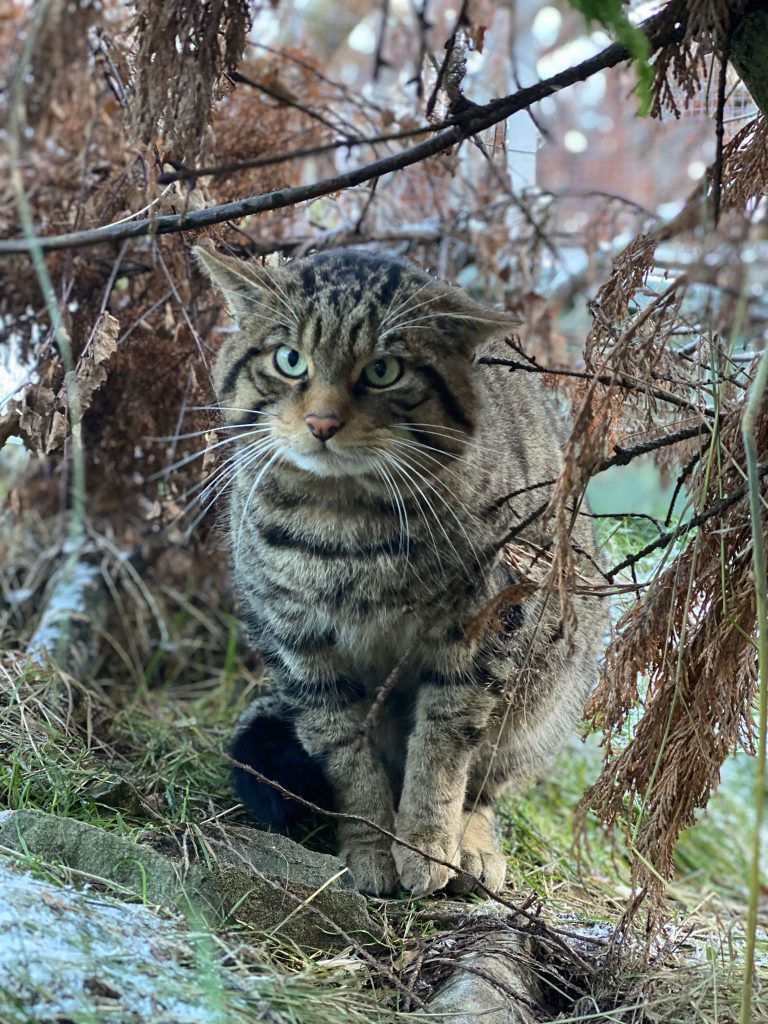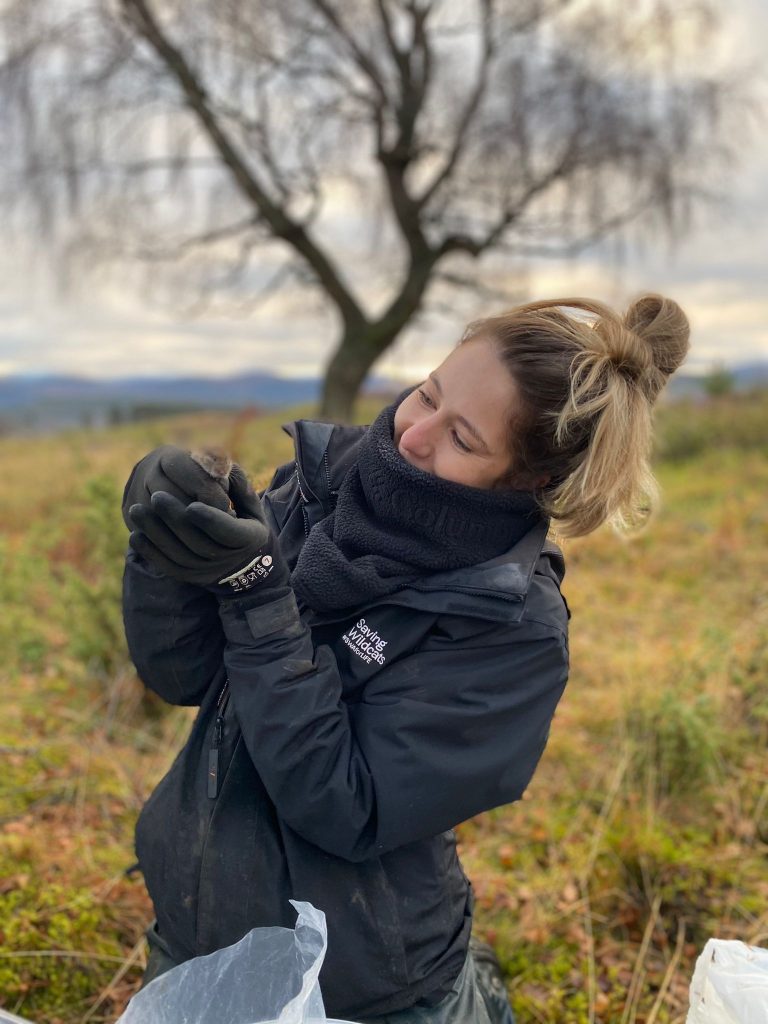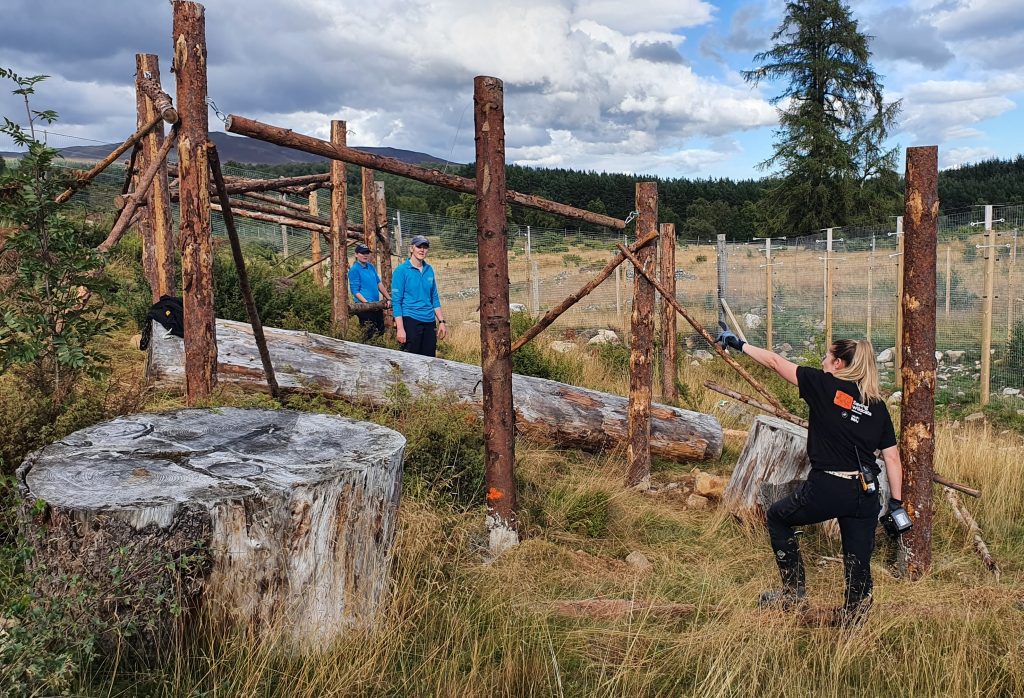The life of a Wildcat Keeper
Estelle is one of the four experienced wildcat keepers on the Saving Wildcats conservation project based at the Royal Zoological Society of Scotland’s Highland Wildlife Park. Saving Wildcats is a European partnership dedicated to Scottish wildcat conservation and recovery. They are aiming to prevent the extinction of wildcats in Scotland by breeding and releasing them into the wild in the Cairngorms National Park, with the first cohort to be released in June.
Estelle is responsible for caring for the wildcats in the UK’s first dedicated conservation breeding for release centre and preparing them for a challenging life in the wild. In this Cairngorms Nature Festival special, we asked her what life is like in her incredibly unique job…

What do you think your younger self would say if you told them you were a wildcat keeper in the Cairngorms National Park?
My younger self would totally think I’ve “made it” with this job. From an early age, I was always obsessed with animals, particularly small mammals that were not well known, as I felt it was my duty to advocate for them! I still remember the day when I, upon reading a book my grandma bought me, discovered wildcats existed and once roamed throughout England and Wales but were now only found in Scotland!
I studied animal management at college and took every opportunity to base my assignments on wildcats as I was fascinated by them. I later then secured my first animal keeper job at a lovely zoo in the Cotswolds. There, I got to work with some incredibly unusual species, but unfortunately wildcats were not one of them!
Starting my career as an animal keeper, I learnt about the significant role zoos play in conservation and, after a few years on the job, I decided I wanted to learn more. I went back to university to undertake a MSc in Conservation and Biodiversity and carried out my dissertation on the foraging ecology of wildcats in Scotland.
Afterwards, I went back to my animal keeping job with so much more appreciation of zoos and how important conservation breeding programmes are for species recovery. I would frequently pester my boss at the time to consider joining the UK’s wildcat conservation breeding programme, so we could teach visitors about their conservation status and threats, but I was unsuccessful in my endeavours!
In 2019, a report was published by the International Union for Conservation of Nature (IUCN) cat specialist group that concluded the Scottish wildcat population is currently ‘non-viable’. This means that there are too few of them to form a self-sustaining population. The report recommended breeding wildcats for release to help recover the population in the wild.
This made me feel a little hopeless about the future of wildcats, but fast forward to summer 2020 and I see a job advertised for a wildcat keeper for the Saving Wildcats project! Supported by the EU LIFE programme and led by the Royal Zoological Society of Scotland (RZSS), this project was going to use the expertise and experience of project partners to build a centre in the Highlands to prevent the Scottish wildcat population from becoming extinct. I quite literally could not believe it, as it was my dream job. A conservation breeding for release project was happening and animal keepers, like me, were needed to help reverse the decline of wildcats. So, of course I applied, and was successful and it really felt like all the pieces of the puzzle were starting to fit together.
What does a typical day look like in your job?
No two days are the same, the wildcats really do keep us keepers busy and on our toes!
Every morning our priority is to get a good visual check on each of the wildcats to make sure they are bright, alert and behaving as a wildcat should. We have an extensive CCTV system that helps with our checks, so we cause as little disturbance to the wildcats as possible. Next, we focus on the animal husbandry: cleaning, feeding, providing fresh water, developing enrichment, topping up bark piles, refreshing cover, replenishing nest boxes, and generally ensuring the enclosures are in tip top condition and that they have all the elements required to make the wildcats feel secure and at home.
The planning and preparation of food for all our wildcats is quite the mammoth task, with their favourite food items being small mammals and rabbits. We vary the food items, amounts and feeding times all while aiming to present the food in an enriching way that allows them to practise essential hunting and feeding behaviours they will need to survive once released.
Aside from practical direct wildcat husbandry, we work hard to collect important data on the wildcats and their behaviour to help create a bigger three-dimensional picture of each individual. Collecting data allows us to make informed, evidenced-based management decisions that help us ensure welfare standards are high and the wildcats are on track for their release as they develop from kitten to adult.
Is there a highlight from your time as a wildcat keeper you could tell us about?
I feel really privileged to have been a part of so many milestones for the project. From the completion of our breeding enclosures back in 2021, to receiving and settling in our first wildcat residents and the arrival of our first kittens. But if I had to pick one stand out highlight, it would have to be discovering my favourite pair of wildcats, Cranachan and Margaret, welcomed a litter of five kittens! Watching Cranachan and Margaret form an established pair, breed, and then watch their five kittens develop into feisty sub-adults as they navigate their journey to the wild is beyond rewarding.

What do you feel is the most challenging thing about being a keeper?
The biggest challenge is that no one has done what we are aiming to do. There is no guidebook on how to breed and release wildcats into Scotland. It is a huge task to prepare a wildcat physically and mentally for release and it’s not as simple as opening the door and letting them go. We must give them the opportunity to develop and refine key behaviours that are critical for their survival, and we need to make sure that they are fit and healthy. There are some things that we will only learn after the first releases.
Aside from that, being a keeper is incredibly physical and taxing on your body! This year alone, we furnished 20 large pre-release enclosures that all required complex and dynamic climbing structures. To create these, we dug approximately 200 holes and moved 40 tonnes of logs all by hand. As you can imagine, I do not need a gym membership!
What would you say is important about the Saving Wildcats project?
Wildcats are the UK’s last remaining wild cat species and will disappear forever from the Cairngorms and wider Scotland without some serious help. This project is incredibly special, not only have we built the first dedicated facility for breeding wildcats for release in the UK, but we have also brought talented and dedicated people together into one team to combine superpowers to help reverse the decline of wildcats. We are supported by experts from across the world, including everyone at RZSS and our project’s other partners NatureScot, Forestry and Land Scotland, the Cairngorms National Park Authority, Nordens Ark and Junta de Andalucía, with support from Cairngorms Connect
For more information about the project, visit savingwildcats.org.uk.
Want to go behind the scenes? As part of the Cairngorms Nature Festival, you can join the Saving Wildcats team at the Highland Wildlife Park on 19 May for a walk, talk and Q&A. Find out more and book here.


